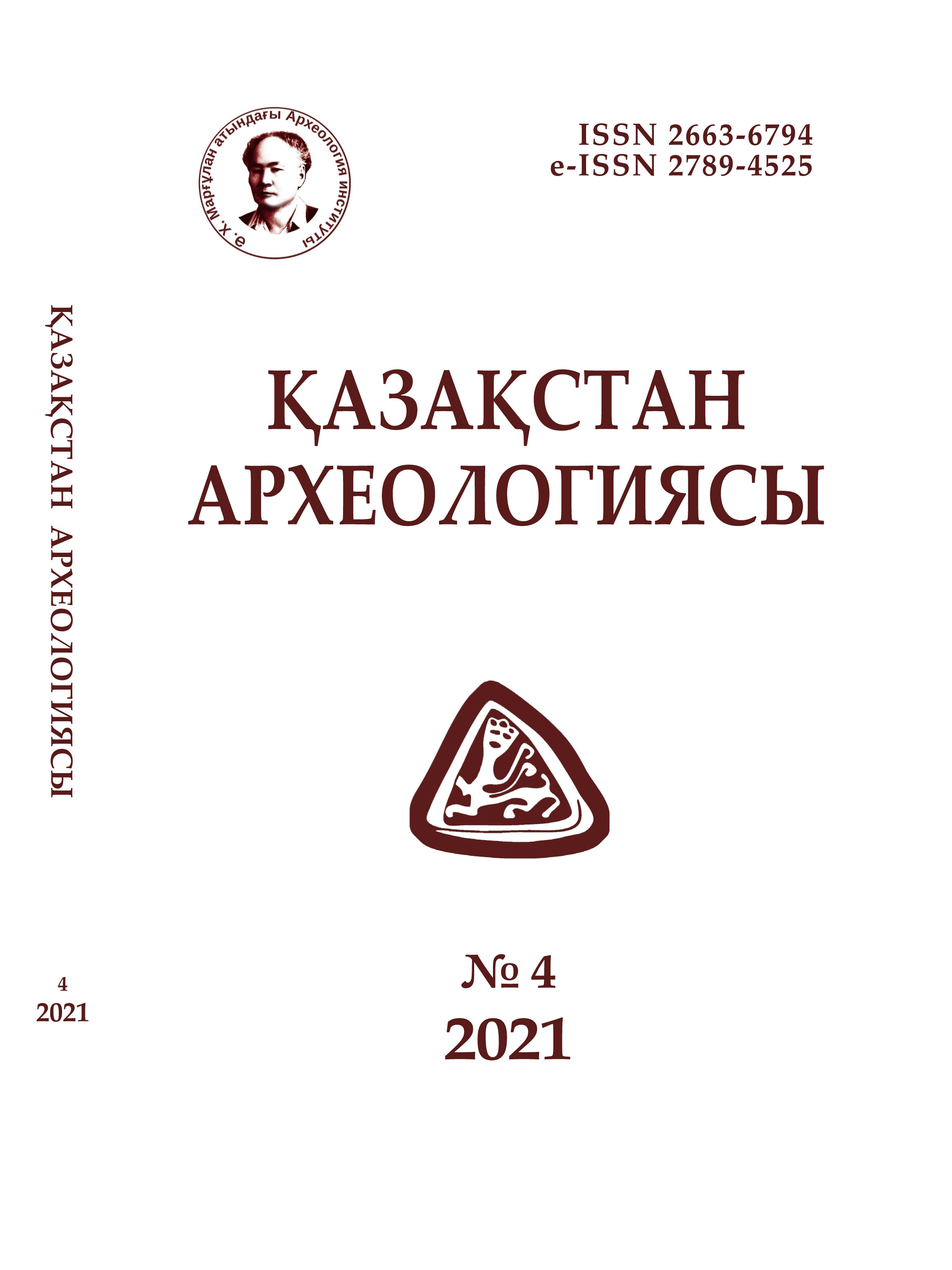Study of historical monuments of the Teniz-Korgalzhyn region: new data
DOI:
https://doi.org/10.52967/akz2021.4.14.92.104Keywords:
Lake Tengiz, Korgalzhyn, Bytygay settlement, Nura, Siberian chronicles, Silk road, historical monuments, expeditionsAbstract
The territory of Tengiz-Korgalzhyn possesses the richness and diversity of the Nura River, Lake Tengiz and the shallow waters of Korgalzhyn. This area is full of historical monuments. Among them are such monuments as Bytygay, Sulu tam, Syrly tam, Alyp tomar, Bespakir, Zhanibek-Shalkar. The first studies were carried out here in 1950–1970s by the Central Kazakhstan archaeological expedition led by A.Kh. Margulan, by the expedition of the Eurasian National University under the leadership of M. Eleuov in 2000, as well as by the expedition of the RGK "Kazrestavratsia" under the leadership of M. Sembin in 2007. And also new data were obtained during the research of the Esil archaeological expedition under the leadership of M. Khabdulina. In the field season of 2021, employees of the State Historical and Cultural Museum-Reserve “Bozok” under the leadership of S. Sakenov and M. Sembi, carried out archaeological excavations on the territory of the medieval settlement Bytygay. The research results bring new data on the urban culture of the Middle Ages in the region. The study of archaeological and cultural monuments remains a topical issue in historical science. Special attention should be paid to military topographic, ecological, seismic-geological maps, etc. It is important to use common geographical names. It should be noted that historical and political events in this area are directly related to the names of settlements and historical monuments, which, on the one hand, were involved in the process of decisive events of the Great Steppe, on the other hand, were important in shaping the future of the Kazakh people. Our short article is an analysis of archival sources from various industries that were rarely used previously in historical works.
References
Arslanova, A. A. 1990. In: Natsionalnyy vopros v Tatarii dooktyabrskogo perioda (National issue in the Tatar in the period before October). Kazan, 4-20 (in Russian).
Artykbayev, Zh. O. 2021. Esil-Nura – eki su. Aqmola oblysy jer-su ataularinin qupiyasy. (Esil-Nura - two waters. The secret of land and water names of Akmola region). Nur-Sultan: L.N. Gumilyov Eurasian National University (in Kazakh).
Akhmedov, B. A. 1965. Gosudarstvo kochevykh uzbekov (State of nomadic Uzbeks). Moscow: “Nauka” Publ. (in Russian).
Eleuov, M. 2000. Saryarka men Chu, Talas, Keles onirlerinin ortagasyrlyk kalalary, mekenderi zhane keruen zholdary (Medieval cities, settlements and caravan routes of Saryarka and Shu, Talas, Keles regions). Report on research work. Astana (in Kazakh).
Er Shora // Babalar sozi: in 100-vol. 2007. Astana: “Foliant” Publ., vol. 45: Batyrlar zhyry (in Kazakh).
Kastaniye, I. A. 1910. Drevnosti Kirgizskoy stepi i Orenburgskogo kraya (Antiquities of the Kyrgyz steppe and the Orenburg region. Orenburg: “Karimov, Khusainov i K” Publ., XVIII (in Russian).
Kozyrev, A. A. 1911. Gidrogeologicheskoye opisaniye yuzhnoy chasti Akmolinskoy oblasti (Hydrogeological description of the southern part of the Akmola region). Saint Petersburg (in Russian).
Zost, A. (ed., compl.). 1880. (Kungurskaya) Kratkaya sibirskaya letopis ((Kungurskaya) Brief Siberian Chronicle). Saint Petersburg: “F.G. Elkonsky” Publ. (in Russian).
In: Babalar sozi: in 100 vol. 2006. Astana: “Foliant” Publ. Vol. 32: Shezhirelik dastandar (in Kazakh).
Margulan, A. Kh, Akishev, K. A., Kadyrbayev, M. K., Orazbayev, A. M. 1966. Drevnyaya kultura Tsentralnogo Kazakhstana (Ancient culture of Central Kazakhstan). Alma-Ata: “Nauka” Publ. (in Russian).
Mikhailov, V. 1893. In: Notes of the West Siberian Department of the Imperial Russian Geographical Society. Book. 15, no. 3. Omsk (in Russian).
Remezov, S. U. 1882. Chertezhnaya kniga Sibiri – 1701 (Drawing book of Siberia – 1701). “S. Remezov” Publ. (in Russian).
Rychkov, P. I. 1887. Topografiya Orenburgskoy gubernii (Topography of the Orenburg province). Saint Petersburg: Imperial Academy of Sciences (in Russian).
Sakenov, S. K., Kukushkin, A. I., Burbayeva, S. B., Bukesheva, G. K., Rakhmankulov, Ye. Zh. 2021. In: Teoriya i praktika arkheologicheskikh issledovaniy, vol. 33, no. 4, 268-279 (in Russian). DOI: 10.14258/33(4).-15.
Sembin, M. K. 1975. Mavzoley. Botagay, Syrly-tam, Sulu-tam (Istoriko-arkheologicheskiye materialy) (Mausoleum. Botagay, Syrly-tam, Sulu-tam. (Historical and archaeological materials)). Alma-Ata (in Russian).
Siyazov, M. 1902. Zapiski Zapadno-Sibirskogo otdela Imperatorskogo Russkogo geograficheskogo obshchestva (Notes of the West Siberian Department of the Imperial Russian Geographical Society). Book. 29. Omsk (in Russian).
Uskenbay, K. Z. 2013. Mirgaleyev, I. M. (ed.). Vostochnyy Dasht-i Kypchak v XIII – nachale XV veka. Problemy etnopoliticheskoy istorii Ulusa Dzhuchi (Eastern Dasht-i Kypchak in the 13th – early 15th centuries. Problems of the Ethnopolitical History of Ulus Jochi). Kazan: “Fen” Publ. (in Russian).
Von-Gern, W. C. 1888. In: Notes of the West Siberian Department of the Imperial Russian Geographical Society. Book. 10. Omsk (in Russian).
Fedchenko, B. 1902. In: Notes of the West Siberian Department of the Imperial Russian Geographical Society. Book. 29. Omsk (in Russian).
Yarygin, S. A. 2011. In: Khabdulina, M. K. (ed.). Margulanovskiye chteniya–2011 (Margulan readings–2011). Astana: L.N. Gumilyov Eurasian National University, 384-391 (in Russian).
Homann, E. 1739. Imperii Russici et Tatariae Universae. Табула. [Map of the Russian Empire and Tartaria]) (in Latin).

Downloads
Published
How to Cite
Issue
Section
License
Copyright (c) 2021 Кажымурат Толегенулы, Алексей Игоревич Кукушкин, Бахытгул Темирбаевна Кулжанова

This work is licensed under a Creative Commons Attribution-NonCommercial 4.0 International License.






